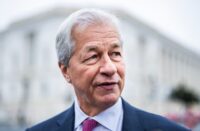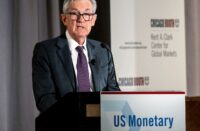As Chair of the U.S. Federal Reserve, Jerome Powell recently testified at a Senate Banking, Housing and Urban Affairs Committee hearing. The primary subject was the Semiannual Monetary Policy Report presented to Congress. This took place on Capitol Hill, Washington, U.S., on February 11, 2025.
The prevalent perspective among Federal Reserve policymakers is that the current policy is appropriately positioned to accommodate any potential risks in the future. However, it might be more precise to suggest that the policy is firmly cemented in place.
Given the multitude of uncertainties present in the current economy and political landscape of Washington, the central bank is essentially playing a waiting game. It is sitting in neutral, anticipating more clarity on what the future may hold.
Atlanta Fed President Raphael Bostic shared in a blog post his observations regarding the mixed feelings about future trade and immigration policies, as well as potential shifts in tax and regulatory policies. This uncertainty adds another layer of complexity to policy making.
The language of the officials has increasingly become cautious, with terms like “well-positioned” becoming a common phrase in post-meeting statements. They have been expressing concerns about the unpredictable nature of President Donald Trump’s aggressive trade and economic policies, and other factors that may sway policy decisions.
The theme of “uncertainty” is increasingly common. Bostic titled his blog post “Uncertainty Calls for Caution, Humility in Policymaking,” emphasizing the cautiousness required in policy decision-making during uncertain times. The minutes from the recent Federal Open Market Committee meeting echoed this sentiment, referring several times to the uncertain climate.
The Fed has a target inflation rate of 2%, a goal that has been elusive for nearly four years. However, St. Louis Fed President Alberto Musalem expressed the potential for inflation to remain high. He also emphasized the need for a “modestly restrictive” policy.
The January minutes pointed to a Fed that is highly conscious of potential shocks and is not interested in making further interest rate adjustments until there’s clearer progress on inflation. The minutes also indicated notable risks to financial stability, particularly concerning leverage and the level of long-duration debt held by banks.
Economist Mark Zandi expressed his concerns about the U.S. bond market, stating that a major sell-off in the bond market could pose a significant risk. Despite this, Zandi believes that there’s a low chance for the Fed to cut rates, as the economy came into 2025 in a relatively stable position.
In conclusion, the current climate and numerous uncertainties mean that the Federal Reserve is holding its position, waiting for more certainty, and being very cautious in policy decision-making. This could impact those looking to invest, as these uncertainties and the Fed’s response could influence market conditions.




